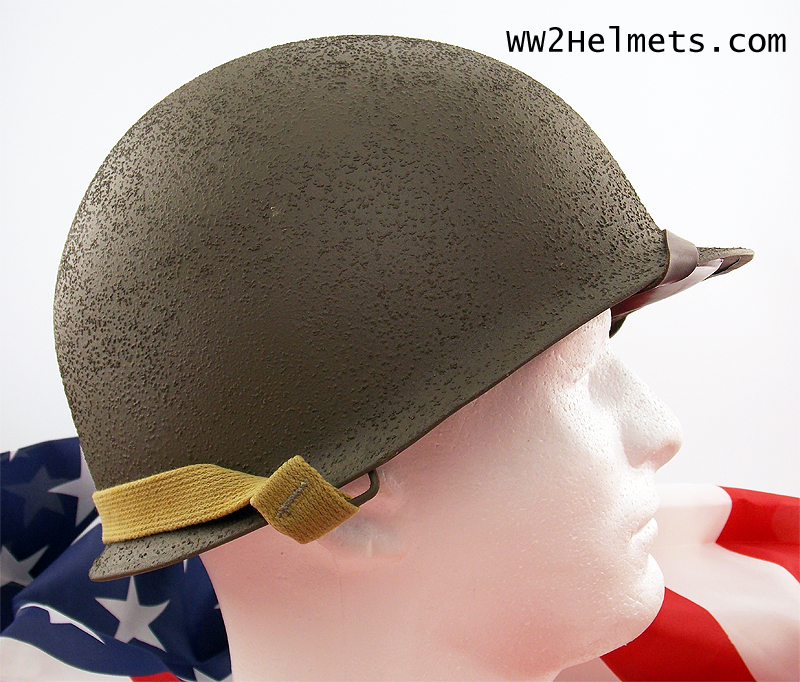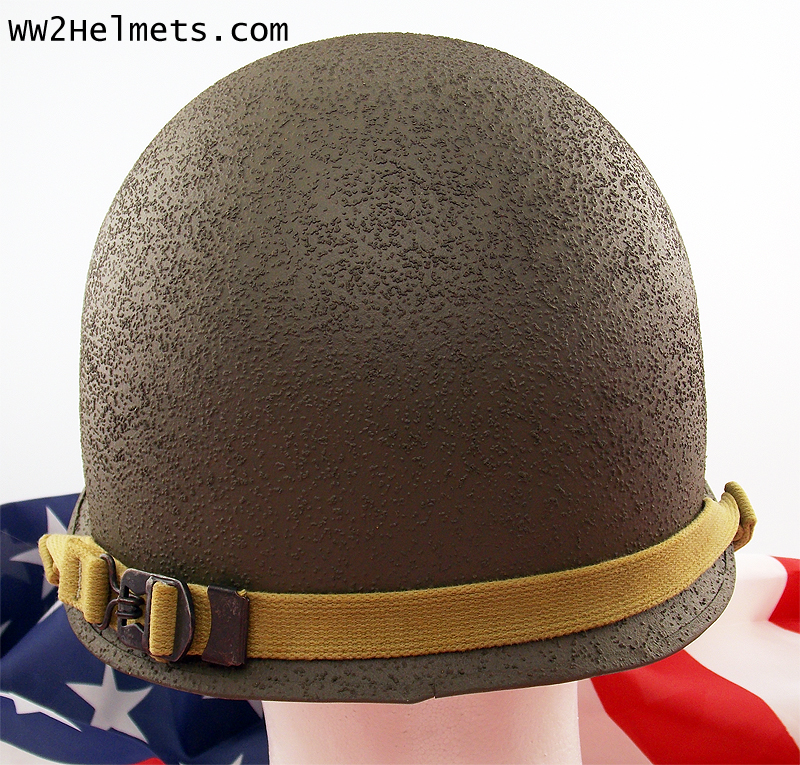The Brodie to the M1: The Evolution of America’s Most Famous Military Helmet
The Brodie Helmet
Few military helmets that have ever been manufactured are as iconic as the Brodie helmet. For a quarter of a century between the early stages of the First World War through to the first years of the Second World War the Brodie was the standard issue headgear for all British troops. Indeed so functional was it and easy to manufacture that the Brodie was purchased by many other countries and the design was adapted by several other European states and even by the United States. Thus, in one guise or another it shaped the design of military helmets all over the world for much of the twentieth century.
The Brodie was the first modern military helmet developed by Britain. When the First World War erupted in the autumn of 1914 all of the major powers were lacking any type of military headgear which could offer effective protection in the face of modern warfare and weaponry. Generally soldiers were still being issued cloth caps or leather headgear of a kind which offered little or no protection from modern artillery and the shrapnel which sprayed out from it. This was particularly the case when it came to trench warfare where shrapnel and debris rained down on soldiers heads from above. Accordingly the main actors in the war quickly began developing new headgear. The first to develop an effective helmet were the French who had developed the steel Adrian helmet by the summer of 1915. The British effort to do so would result in the Brodie.
The Brodie helmet was designed by John Leopold Brodie, a Lithuanian entrepreneur and inventor who had first made his fortune working the gold and diamond mines of South Africa in the 1890s and 1900s and had then moved to Britain. He was in his early forties when the war broke out and he turned his attentions to developing a military helmet along the lines that the French had just produced with the Adrian helmet. In August 1915 he acquired a patent for a steel helmet design of his own, one which could be produced from a single sheet of steel pressed into the first basic Brodie helmet. It was in production already in the summer of 1915 when he was issued with his patent, but it would quickly evolve into a new design in the autumn as some deficiencies in the original were quickly removed and improvements were introduced.
The design of the helmet is familiar to anyone who has seen a First World War movie. The helmet resembles an upside down dishpan or washbasin in that it consists of a bowl-shaped cap and a large uniform brim running around the entire exterior. It was owing to its shape that the German forces on the Western Front began to refer to the helmet as the Salatschüssel or ‘salad bowl’. Unlike the ubiquitous Stahlhelm which had been developed by the Germans around the same time the Brodie did not have a nape piece extending further down at the back to protect the neck, however, it did offer greater all round protection from shrapnel descending down into the trenches. It was made of mild steel originally, but this was quickly dispensed with and a harder type of steel was introduced alloyed with manganese, a mixture known as Hadfield Steel after its developer, the English metallurgist, Sir Robert Hadfield. The helmet was painted a camouflage mix of green, blue and orange, though a variety of alternative colours were also introduced for use in different theatres. The finalised model which went into mass production using Hadfield Steel from late 1915 onwards weighed 2.4 pounds or 1.1. kgs.
The first Brodie helmets entered service in September 1915 but the number of them being produced at this early date was so limited that they were stored in the trenches and given to individuals who were most susceptible to attacks on a given day. Production increased rapidly in 1916 and by that summer over a million units had been produced. By this time a number of additional changes had been introduced to the rim design and the helmet was now known as the Mark I. Nevertheless the Brodie name persisted for many years afterwards.
It was also in 1916 that the British began supplying large numbers of Brodie helmets to their allies. Significantly, over 400,000 Brodies were sold to the United States for use in France after they joined the war in April 1917. Similarly other late entrants into the war such as Portugal relied on supplies of the Brodie to protect the heads of their troops. As the use of the helmet spread it became known by several other names, including the shrapnel helmet, the battle bowler (owing to its resemblance to a bowler hat), the Tommy helmet (owing to its employment by American troops), the tin hat and the doughboy helmet, doughboy being a widely used name for American infantrymen during the First World War.
In total approximately seven and a half million Brodies were produced by the British by the time that the First World War came to an end in November 1918. Yet its use did not stop there. It continued in use through the relatively peaceful years of the 1920s and when war loomed again in the late 1930s it was still in use. Moreover, many Commonwealth nations and other countries associated with Britain such as Australia, New Zealand, Canada and South Africa began producing their own versions in the interwar years, while adapted versions of the Brodie were also used in some civilian settings in Britain, notably by the police and fire brigade.
The final push in using the Brodie was a variant which was produced in 1936 and which saw widespread service by the Norwegians during the German invasion of their country in the spring of 1940 and by the British Expeditionary Force in France several weeks later. The development of a replacement model, the Mark II, and its widespread distribution from 1940 onwards meant that the evacuation from Dunkirk was one of the last military campaigns during which the original Brodie was worn extensively by British troops. Thus, over a quarter of a century it had seen widespread service from the trenches of northern France in 1915 to the flight from that same region twenty-five years later, an action which ensured that Britain could continue the fight against Nazi Germany. Yet, as well will now see, the Brodie’s legacy was even greater, for it provided the template for the more influential M1 helmet which was developed in America and which is the most significant military helmet of the twentieth century.
The M1 Helmet
Few military helmets, whether in modern times, or further back, have the distinction of being used in over ten major wars. Yet there is one piece of military headgear from the twentieth century which was used not just in the Second World War, but also in the Korean War, the Indochina or Vietnam War, the Iran-Iraq War, the Falklands War, the Yugoslav Wars, the First Gulf War and a range of smaller conflicts such as the Cambodian Civil War and several localized clashes in Central America and the Caribbean during the 1970s and the 1980s. This was the American M1 helmet, arguably the most iconic and recognizable military helmet produced in modern times.
Incredibly, given that the M1 was being used by some advanced militaries as recently as the 1990s and is still employed by a few countries today, the development of it dates back to the First World War in the mid-1910s. Upon the United States’ entry into the global conflict in April 1917 it urgently needed supplies of the new kinds of steel military headgear which the French, British and Germans had developed since 1915. Accordingly, the American government purchased hundreds of thousands of Brodie helmets from the British as a stop-gap measure. Simultaneously, though, the administration of Woodrow Wilson ordered the production of an American-made helmet. The resulting product, which was ready for mass production in 1917, was the M1917, the direct predecessor of the M1. Nearly three million of these M1917 helmets were produced by the time that the war ended in November 1918, clearly indicating the importance of an effective military helmet for the American armed forces going forward.
Twenty years of peace followed the end of the First World War before another major international conflict broke out. As usually occurs during such periods of protracted stability, investment in innovations in military equipment was limited and there was no real urgency to develop new weapons and protective equipment. Nevertheless there was some effort to produce a more advanced version of the M1917. In the years after the end of the war the American Infantry Board tested a number of new models, but each of these were deemed to not mark any real improvement on the earlier design. As a result, when the spectre of another war breaking out in Europe raised its head in the mid-1930s the US military were still arming infantrymen with the M1917. Consequently the Infantry Board resumed its experiments to produce a new design. The result in 1940 was the M1, which was effectively an altered version of the M1917.
The M1 came in two parts, a hard metal shell or cap on the outside, and an inner liner hat made out of softer and more malleable materials. The main part of the helmet was the steel shell or cap which was produced from non-magnetic Hadfield Steel, a steel and manganese alloy similar to that which the British had begun to employ to make the Brodie helmet as early as 1916. The steel cap could not be used without the liner, but the liner could be worn on its own and indeed was regularly employed for this purpose in ceremonial settings within the army, or as protective headgear in civil society, by, for instance, policemen and fire brigades. The Brodie had also been employed in this way by the British in the inter-war period. The shape of the helmet was also somewhat similar to the Brodie in that it was based around a circular steel cap which provided maximum protection to the top of the head, with the rim protecting the ears and upper face. However, the M1 sits further back on the head than the Brodie, thus providing greater protection to the neck. In total the steel cap, liner and the accoutrements such as the chinstrap weighed 2.85 pounds or 1.29 kgs.
The M1 offered exceptional protection. It could resist a shot from a pistol fired at it from point blank range. A later study at the end of the Second World War would show that approximately 54% of bullets which hit the M1 of servicemen in Europe and the Pacific failed to penetrate the helmet. As a result, it was estimated that the M1 had saved the lives of approximately 70,000 men between the outbreak of the war in late 1941 and its conclusion in the autumn of 1945.
More innovatively the steel cap was also used as a multi-purpose device by American soldiers during the Second World War. When separated from the liner, the steel cap could be used for many different things. For instance, we are all familiar with American troops digging up foxholes to serve as make-shift beds and trenches during the Battle of the Bulge in Belgium and eastern France in the winter of 1944. Often American GIs used the steel cap from the M1 as a rudimentary entrenching tool to dig these foxholes. Similarly, the cap, when turned upside down, could be used for everything from a bowl for eating to a washbasin for shaving and rinsing to a miniature bucket. It was also used regularly for cooking or heating up food, though the practice was discouraged, as over time it made the metal more brittle and the helmet less effective at protecting the wearer if he was shot in the head.
While the basic structure of the M1 remained relatively unchanged in the years that followed, the liner went through many different designs. Originally this was a hard-hat like support which was designed to fit inside the steel cap, offering comfort, support and an extra layer of protection. One of the main purposes of it was to essentially allow the head to breathe and sweat inside the steel cap. While they were initially produced from manufactured paper fibres, these models were quickly discontinued when it was realised that they degraded in short order, particularly in the tropical conditions of the Pacific War in 1942 and 1943. Consequently a plastic liner, engineered by the car company, General Motors, was introduced, and it was this method, albeit with some alterations to the chin straps and other accoutrements, which was employed for decades in conflicts such as the Korean War and the Vietnam War.
The M1 became the standard issue helmet for American servicemen during the Second World War following the US’s entry into the conflict in the aftermath of the Japanese attack on Pearl Harbour in December 1941. Over the next nearly four years down to the end of the war in August 1945 over 22 million M1s were produced, either for use by America or its allies. And use of the M1 helmet did not end in 1945; far from it. It was the standard military issue helmet, albeit with some slight alterations to it, for American soldiers in the Korean War and the Vietnam War, as well as a whole host of smaller conflicts and deployments down to the early 1980s.
And this only accounts for its use by the American military. Such was the model’s effectiveness that large numbers of it were either purchased by nations from the US, or they developed their own clone or copycat models. The M1 was eventually used in virtually every part of the globe, certainly everywhere that fell within the American sphere of influence during the Cold War, from the Balkans to much of South America and from West Germany to Singapore. Some developed nations such as Australia and Canada even continued to use it well into the 1990s. Indeed, a domestically produced version of the M1 is still in use today amongst the Indian armed forces, as well as several other countries such as Vietnam, Turkey and Colombia, albeit often in a ceremonial capacity.
The M1 was only finally replaced as the standard issue military helmet for the United States armed forces in 1983, over forty years after it first entered mass production. It was superseded by the Personnel Armor System for Ground Troops or PASGT, a combination type of armour consisting of a ballistics vest and a combat helmet. The PASGT helmet was a new generation of combat helmet, being made from nineteen layers of Kevlar, a light-weight synthetic fibre material which offered higher levels of protection than the manganese-steel alloy from which the M1s had been manufactured.
In conclusion, the M1 can probably be designated as the most successful combat helmet ever made. Its service history within the US armed forces spans a period of over forty years, being the standard issue military headgear for American soldiers between 1941 and 1983 and inspiring imitation models around the world. Accordingly many countries have used the M1 themselves until recently, while a small number of countries continue to use this Second World War helmet in their armed forces.




